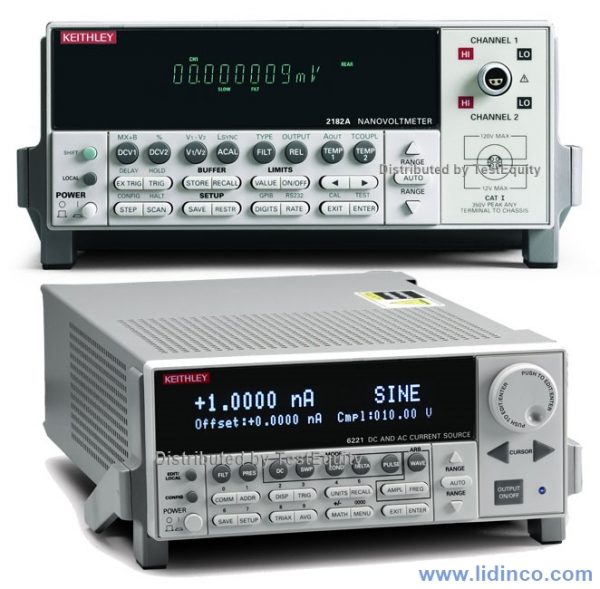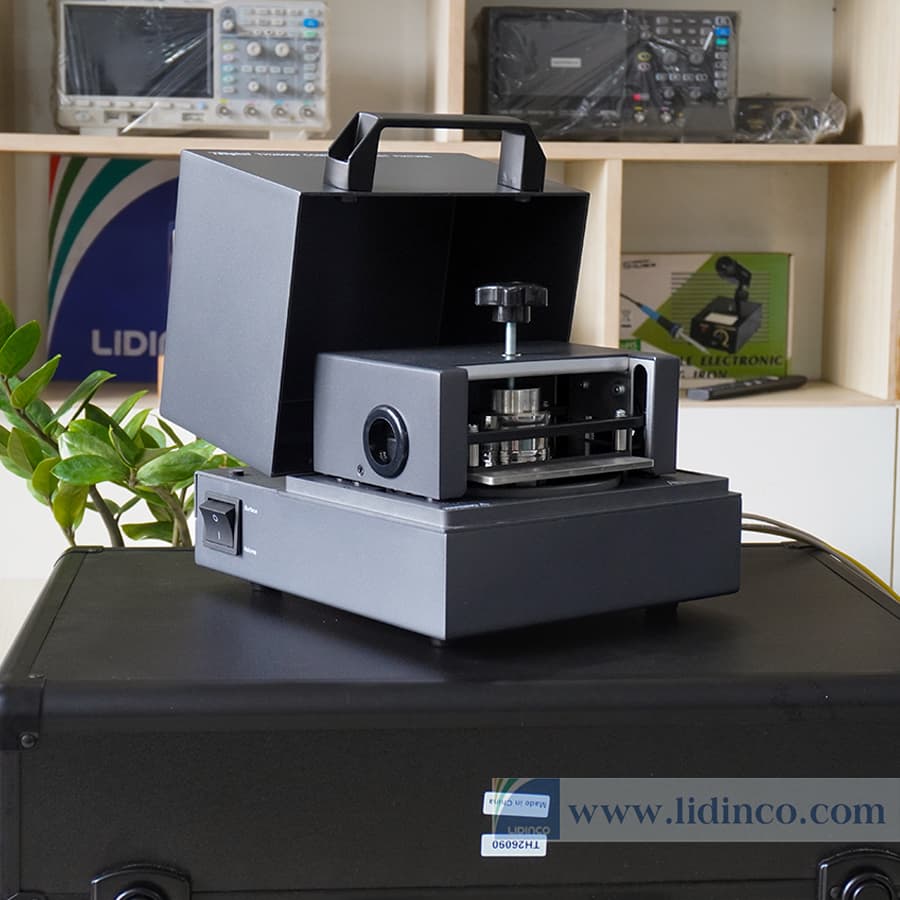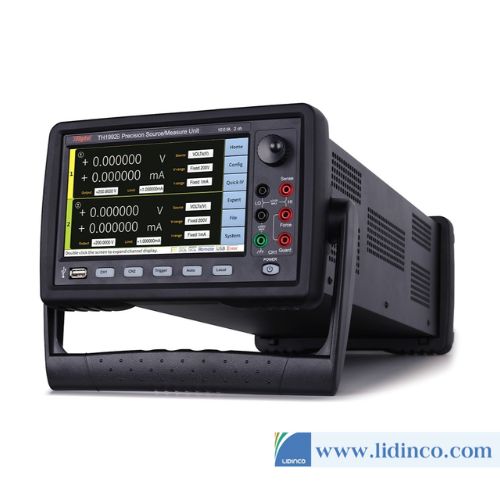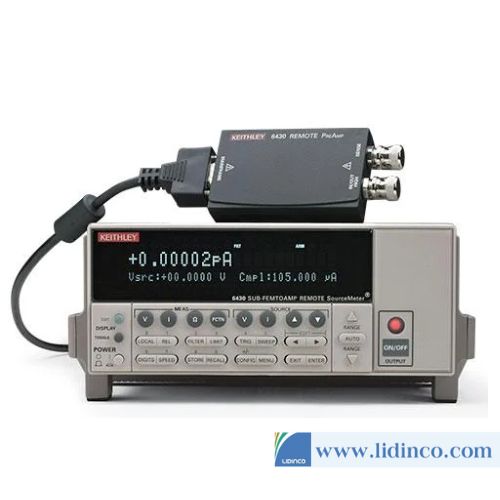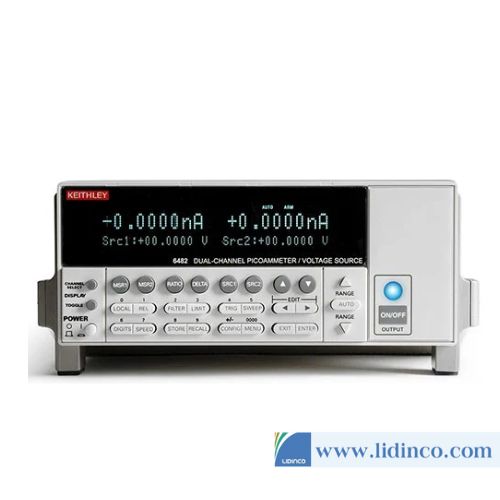Hệ thống sourcemeter Keithley 6220/2182A Delta Model
Hệ thống sourcemeter Keithley 6220/2182A Delta Model
-
Nguồn áp:
-
Độ phân giải dòng:
-
Độ phân giải áp:
- Đang có sẵn: Vui lòng liên hệ
- Tạm thời chưa có khuyến mãi cho sản phẩm này
Hotline: 0906.988.447
Liên hệ: Hồ Chí Minh
- Điện thoại: (028).3977.8269
- Email: sales@lidinco.com
- Địa chỉ: 487 Cộng Hòa, Phường Tân Bình, TP. Hồ Chí Minh, Việt Nam
Liên hệ: Bắc Ninh, Hà Nội
- Điện thoại: (0222).730.0180
- Email: bn@lidinco.com
- Địa chỉ: 184 Bình Than, Phường Võ Cường, Bắc Ninh, Việt Nam
-
 Tư vấn kĩ thuật
Miễn phí
Tư vấn kĩ thuật
Miễn phí
-
 Miễn phí vận chuyển
Đơn hàng trên 3 triệu
Miễn phí vận chuyển
Đơn hàng trên 3 triệu
Điện áp: 250V rms, DC to 60Hz
Chế độ cách ly: >10 9 Ω, <2nF
Chế độ cổng ra: Fixed DC level, Memory List
Giao diện điều khiến từ xa:
IEEE-488 and RS-232C.
SCPI (Standard Commands for Programmable Instruments).
DDC (command language compatible with Keithley Model 220).
Mật khẩu: 11 ký tự
Giao diện sử lý: Start of test, end of test, 3 category bits, +5V@300mA supply
Kỹ thuật I/O: 1 trigger input, 4 TTL/Relay Drive outputs (33V@500mA, diode clamped)
Kết nối cổng ra:
Teflon insulated 3-lug triax connector for output.
Banana safety jack for GUARD, OUTPUT LO.
Screw terminal for CHASSIS.
DB-9 connector for EXTERNAL TRIGGER INPUT, OUTPUT, and DIGITAL I/O.
Two position screw terminal for INTERLOCK.
Khóa INTERLOCK: Maximum 10Ω external circuit impedance
Nguồn cấp: 100V to 240V rms, 50–60Hz
Năng lượng tiêu thụ: 120VA
Độ chính xác: ±(0.1% of output + 1mV)
Bộ nhớ: 1024 readings
Hệ thống sourcemeter để bàn Keithley 6220/2182A
Delta Model System with DC Current Source and Nanovoltmeter
The need for precision, low current sourcing. Device testing and characterization for today's very small and power-efficient electronics requires sourcing low current levels, which demands the use of a precision, low current source. Lower stimulus currents produce lower -- and harder to measure -- voltages across the device. Combining the Model 6220 DC Current Source or Model 6221 AC and DC Current Source with a Model 2182A Nanovoltmeter makes it possible to address both of these challenges.
Differential Conductance. Differential conductance measurements are among the most important and critical measurements made on non-linear tunneling devices and on low temperature devices. Mathematically, differential conductance is the derivative of a device's I-V curve. The Model 6220 or 6221, combined with the Model 2182A, is the industry's most complete solution for differential conductance measurements. Together, these instruments are also the fastest solution available, providing 10x the speed and significantly lower noise than other options. Data can be obtained in a single measurement pass, rather than by averaging the result of multiple sweeps, which is both time-consuming and prone to error. The Model 622X and Model 2182A are also easy to use because the combination can be treated as a single instrument. Their simple connections eliminate the isolation and noise current problems that plague other solutions.
Keithley 6220 DC Precision Current Source
The Model 6220 DC Current Source and Model 6221 AC and DC Current Source combine ease of use with exceptionally low current noise. Low current sourcing is critical to applications in test environments ranging from R&D to production, especially in the semiconductor, nanotechnology, and super-conductor industries. High sourcing accuracy and built-in control functions make the Models 6220 and 6221 ideal for applications like Hall measurements, resistance measurements using delta mode, pulsed measurements, and differential conductance measurements.
The need for precision, low current sourcing. Device testing and characterization for today's very small and power-efficient electronics requires sourcing low current levels, which demands the use of a precision, low current source. Lower stimulus currents produce lower and harder to measure voltages across the device. Combining the Model 6220 or 6221 with a Model 2182A Nanovoltmeter makes it possible to address both of these challenges.
AC current source and current source waveform generator. The Model 6221 is the only low current AC source on the market. Before its introduction, researchers and engineers were forced to build their own AC current sources. This cost-effective source provides better accuracy, consistency, reliability, and robustness than "home-made" solutions. The Model 6221 is also the only commercially available current source waveform generator, which greatly simplifies creating and outputting complex waveforms.
Simple programming. Both current sources are fully programmable via the front panel controls or from an external controller via RS-232 or GPIB interfaces; the Model 6221 also features an Ethernet interface for remote control from anywhere there's an Ethernet connection. Both instruments can source DC currents from 100fA to 105mA; the Model 6221 can also source AC currents from 4pA to 210mA peak to peak. The output voltage compliance of either source can be set from 0.1V to 105V in 10mV steps. Voltage compliance (which limits the amount of voltage applied when sourcing a current) is critical for applications in which overvoltages could damage the device under test (DUT).
Drop-in replacement for the Model 220 current source. These instruments build upon Keithley's popular Model 220 Programmable Current Source; a Model 220 emulation mode makes it easy to replace a Model 220 with a Model 6220/6221 in an existing application with-out rewriting the control code.
Define and execute current ramps easily. Both the Models 6220 and 6221 offer tools for defining current ramps and stepping through predefined sequences of up to 65,536 output values using a trigger or a timer. Both sources support linear, logarithmic, and custom sweeps.
The Model 6221's combination of high source resolution and megahertz update rates makes it capable of emulating high fidelity current signals that are indistinguishable from analog current ramps.
Free Instrument Control Example Start-up Software
The instrument control example software available for the sources simplifies both performing basic sourcing tasks and coordinating complex measurement functions with the Keithley Model 2182A. The software, developed in the LabVIEW ® programming environment, includes a step-by-step measurement guide that helps users set up their instruments and make proper connections, as well as program basic sourcing functions. The advanced tools in the package support delta mode, differential conductance, and pulse mode measurements. From this package, users can print out the instrument commands for any of the pre-programmed functions, which provides a starting point for incorporating these functions into customized applications.
Differential Conductance
Differential conductance measurements are among the most important and critical measurements made on non-linear tunneling devices and on low temperature devices. Mathematically, differential conductance is the derivative of a device's I-V curve. The Model 6220 or 6221, combined with the Model 2182A Nano voltmeter, is the industry's most complete solution for differential conductance measurements. Together, these instruments are also the fastest solution available, providing 10× the speed and significantly lower noise than other options. Data can be obtained in a single measurement pass, rather than by averaging the result of multiple sweeps, which is both time-consuming and prone to error. The Model 622X and Model 2182A are also easy to use because the combination can be treated as a single instrument. Their simple connections eliminate the isolation and noise current problems that plague other solutions.
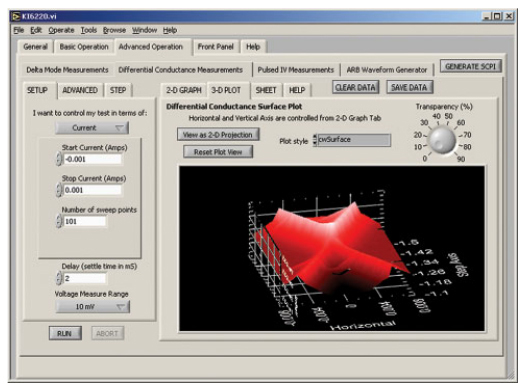
Figure 1. Perform, analyze, and display differential conductance measurements.
Delta Mode
Keithley originally developed the delta mode method for making low noise measurements of voltages and resistances for use with the Model 2182 Nanovoltmeter and a triggerable external current source. Essentially, the delta mode automatically triggers the current source to alternate the signal polarity, then triggers a nanovoltmeter reading at each polarity. This current reversal technique cancels out any constant thermoelectric offsets, ensuring the results reflect the true value of the voltage.
This same basic technique has been incorporated into the Model 622X and Model 2182A delta mode, but its implementation has been dramatically enhanced and simplified. The technique can now cancel thermoelectric offsets that drift over time, produce results in half the time of the previous technique, and allow the source to control and configure the nanovoltmeter, so setting up the measurement takes just two key presses. The improved cancellation and higher reading rate reduces measurement noise to as little as 1nV.
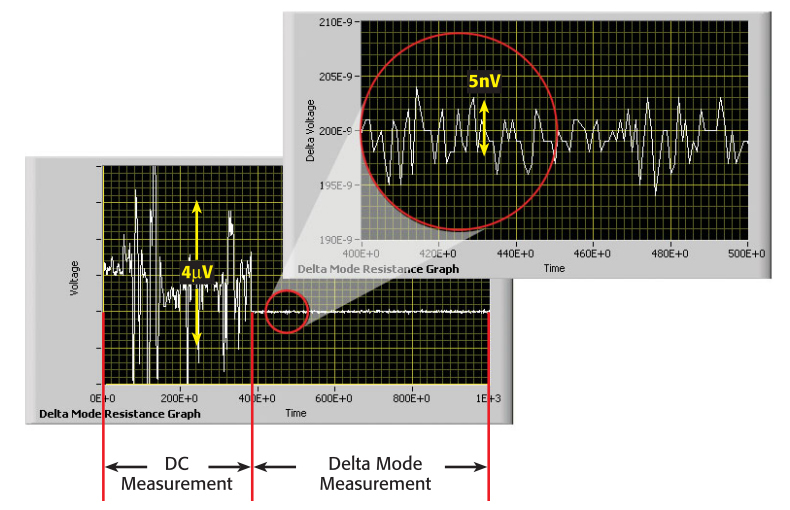
Figure 2. Delta mode offers 1000-to-1 noise reduction.
The delta mode enables measuring low voltages and resistances accurately. Once the Model 622X and the Model 2182A are connected properly, the user simply presses the current source's Delta button, followed by the Trigger button, which starts the test. The Model 622X and the Model 2182A work together seamlessly and can be controlled via the GPIB interface (GPIB or Ethernet with the Model 6221). The free example control software available for the Model 622X includes a tutorial that "walks" users through the delta mode setup process.
Pulsed Tests
Even small amounts of heat introduced by the measurement process itself can raise the DUT's temperature, skewing test results or even destroying the device. The Model 6221's pulse measurement capability minimizes the amount of power dissipated into a DUT by offering maximum flexibility when making pulsed measurements, allowing users to program the optimal pulse current amplitude, pulse interval, pulse width, and other pulse parameters.
The Model 6221 makes short pulses (and reductions in heat dissipation) possible with microsecond rise times on all ranges. The Model 6221/2182A combination synchronizes the pulse and measurement. a measurement can begin as soon as 16µs after the Model 6221 applies the pulse. The entire pulse, including a complete nanovolt measurement, can be as short as 50µs. Line synchronization between the Model 6221 and Model 2182A eliminates power line related noise.
Standard and Arbitrary Waveform Generator
The Model 6221 is the only low current AC source on the market. It can be programmed to generate both basic waveforms (sine, square, triangle, and ramp) and customizable waveforms with an arbitrary waveform generator (ARB) that supports defining waveforms point by point. It can generate waveforms at frequencies ranging from 1mHz to 100kHz at an output update rate of 10 megasamples/ second.
Performance Superior to AC Resistance Bridges and Lock-In Amplifiers
The Model 622X/2182A combination provides many advantages over AC resistance bridges and lock-in amplifiers, including lower noise, lower current sourcing, lower voltage measurements, less power dissipation into DUTs, and lower cost. It also eliminates the need for a current pre-amplifier.
The Model 6221 can also expand the capabilities of lock-in amplifiers in applications that already employ them. For example, its clean signals and its output synchronization signal make it an ideal output source for lock-in applications such as measuring second and third harmonic device response.
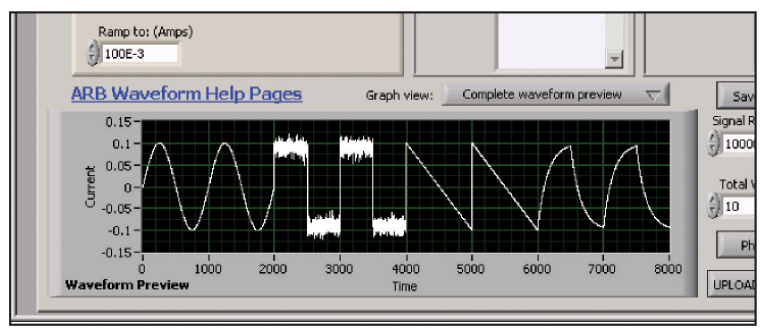
Figure 4. The Model 6221 and the free example start-up control software make it easy to create complex waveforms by adding, multiplying, stringing together, or applying filters to standard wave shapes.
Models 6220 and 6221 vs. Homemade Current Sources
Many researchers and engineers who need a current source attempt to get by with a voltage source and series resistor instead. This is often the case when an AC current is needed. This is because, until the introduction of the Model 6220/6221, no AC current sources were available on the market. However, homemade current sources have several disadvantages vs. true current sources:
Homemade Current Sources Don’t Have Voltage Compliance. You may want to be sure the voltage at the terminals of your homemade “current source” never exceeds a certain limit (for example, 1–2V in the case of many optoelectronic devices). The most straightforward way to accomplish this is to reduce the voltage source to that level. This requires the series resistor to be reduced to attain the desired current. If you want to program a different current, you must change the resistor while the voltage is held constant! Another possibility is to place a protection circuit in parallel with the DUT. These do not have precise voltage control and always act as a parallel device, stealing some of the programmed current intended for the DUT.
Homemade Current Sources Can’t Have Predictable Output. With a homemade “current source” made of a voltage source and series resistor, the impedance of the DUT forms a voltage divider. If the DUT resistance is entirely predictable, the current can be known, but if the DUT resistance is unknown or changes, as most devices do, then the current isn’t a simple function of the voltage applied. The best way to make the source predictable is to use a very high value series resistor (and accordingly high voltage source), which is in direct contradiction with the need for compliance.
While it’s possible to know (if not control) the actual current coming from such an unpredictable source, this also comes at a cost. This can be done with a supplemental measurement of the current, such as using a voltmeter to measure the voltage drop across the series resistor. This measure- ment can be used as feedback to alter the voltage source or simply recorded. Either way, it requires additional equipment, which adds complexity or error. To make matters worse, if the homemade current source is made to be moderately predict- able by using a large series resistor, this readback would require using an electrom- eter to ensure accuracy.
APPLICATIONS
Nanotechnology
Differential conductance
Pulsed sourcing and resistance
Optoelectronics
Pulsed I-V
Replacement for AC resistance bridges (when used with Model 2182A)
Measuring resistance with low power
Replacement for lock-in amplifiers (when used with Model 2182A)
Measuring resistance with low noise
Keithley 2182A Digital Nanovoltmeter & Low Voltage Meters
The two-channel Model 2182A Nanovoltmeter is optimized for making stable, low noise voltage measurements and for characterizing low resistance materials and devices reliably and repeatably. It provides higher measurement speed and significantly better noise performance than alternative low voltage measurement solutions.
The Model 2182A represents the next step forward in Keithley nanovoltmeter technology, replacing the original Model 2182 and offering enhanced capabilities including pulse capability, lower measurement noise, faster current reversals, and a simplified delta mode for making resistance measurements in combination with a reversing current source, such as the Model 6220 or 6221.
Flexible, Effective Speed/Noise Trade-offs
The Model 2182A makes it easy to choose the best speed/filter combination for a particular application’s response time and noise level requirements. The ability to select from a wide range of response times allows optimizing speed/noise trade-offs. Low noise levels are assured over a wide range of useful response times, e.g., 15nV p-p noise at 1s and 40-50nV p-p noise at 60ms are typical. Figure 1illustrates the Model 2182A’s noise performance.Figure 4. The Model 6221 and the free example start-up control software make it easy to create complex waveforms by adding, multiplying, stringing together, or applying filters to standard wave shapes.
Models 6220 and 6221 vs. Homemade Current Sources
Many researchers and engineers who need a current source attempt to get by with a voltage source and series resistor instead. This is often the case when an AC current is needed. This is because, until the introduction of the Model 6220/6221, no AC current sources were available on the market. However, homemade current sources have several disadvantages vs. true current sources:
Homemade Current Sources Don’t Have Voltage Compliance. You may want to be sure the voltage at the terminals of your homemade “current source” never exceeds a certain limit (for example, 1–2V in the case of many optoelectronic devices). The most straightforward way to accomplish this is to reduce the voltage source to that level. This requires the series resistor to be reduced to attain the desired current. If you want to program a different current, you must change the resistor while the voltage is held constant! Another possibility is to place a protection circuit in parallel with the DUT. These do not have precise voltage control and always act as a parallel device, stealing some of the programmed current intended for the DUT.
Homemade Current Sources Can’t Have Predictable Output. With a homemade “current source” made of a voltage source and series resistor, the impedance of the DUT forms a voltage divider. If the DUT resistance is entirely predictable, the current can be known, but if the DUT resistance is unknown or changes, as most devices do, then the current isn’t a simple function of the voltage applied. The best way to make the source predictable is to use a very high value series resistor (and accordingly high voltage source), which is in direct contradiction with the need for compliance.
While it’s possible to know (if not control) the actual current coming from such an unpredictable source, this also comes at a cost. This can be done with a supplemental measurement of the current, such as using a voltmeter to measure the voltage drop across the series resistor. This measure- ment can be used as feedback to alter the voltage source or simply recorded. Either way, it requires additional equipment, which adds complexity or error. To make matters worse, if the homemade current source is made to be moderately predict- able by using a large series resistor, this readback would require using an electrom- eter to ensure accuracy.
APPLICATIONS
Nanotechnology
Differential conductance
Pulsed sourcing and resistance
Optoelectronics
Pulsed I-V
Replacement for AC resistance bridges (when used with Model 2182A)
Measuring resistance with low power
Replacement for lock-in amplifiers (when used with Model 2182A)
Measuring resistance with low noise
Keithley 2182A Digital Nanovoltmeter & Low Voltage Meters
The two-channel Model 2182A Nanovoltmeter is optimized for making stable, low noise voltage measurements and for characterizing low resistance materials and devices reliably and repeatably. It provides higher measurement speed and significantly better noise performance than alternative low voltage measurement solutions.
The Model 2182A represents the next step forward in Keithley nanovoltmeter technology, replacing the original Model 2182 and offering enhanced capabilities including pulse capability, lower measurement noise, faster current reversals, and a simplified delta mode for making resistance measurements in combination with a reversing current source, such as the Model 6220 or 6221.
Flexible, Effective Speed/Noise Trade-offs
The Model 2182A makes it easy to choose the best speed/filter combination for a particular application’s response time and noise level requirements. The ability to select from a wide range of response times allows optimizing speed/noise trade-offs. Low noise levels are assured over a wide range of useful response times, e.g., 15nV p-p noise at 1s and 40-50nV p-p noise at 60ms are typical. Figure 1illustrates the Model 2182A’s noise performance.Figure 4. The Model 6221 and the free example start-up control software make it easy to create complex waveforms by adding, multiplying, stringing together, or applying filters to standard wave shapes.
Models 6220 and 6221 vs. Homemade Current Sources
Many researchers and engineers who need a current source attempt to get by with a voltage source and series resistor instead. This is often the case when an AC current is needed. This is because, until the introduction of the Model 6220/6221, no AC current sources were available on the market. However, homemade current sources have several disadvantages vs. true current sources:
Homemade Current Sources Don't Have Voltage Compliance. You may want to be sure the voltage at the terminals of your homemade "current source" never exceeds a certain limit (for example, 1--2V in the case of many optoelectronic devices). The most straightforward way to accomplish this is to reduce the voltage source to that level. This requires the series resistor to be reduced to attain the desired current. If you want to program a different current, you must change the resistor while the voltage is held constant! Another possibility is to place a protection circuit in parallel with the DUT. These do not have precise voltage control and always act as a parallel device, stealing some of the programmed current intended for the DUT.
Homemade Current Sources Can't Have Predictable Output. With a homemade "current source" made of a voltage source and series resistor, the impedance of the DUT forms a voltage divider. If the DUT resistance is entirely predictable, the current can be known, but if the DUT resistance is unknown or changes, as most devices do, then the current isn't a simple function of the voltage applied. The best way to make the source predictable is to use a very high value series resistor (and accordingly high voltage source), which is in direct contradiction with the need for compliance.
While it's possible to know (if not control) the actual current coming from such an unpredictable source, this also comes at a cost. This can be done with a supplemental measurement of the current, such as using a voltmeter to measure the voltage drop across the series resistor. This measure- ment can be used as feedback to alter the voltage source or simply recorded. Either way, it requires additional equipment, which adds complexity or error. To make matters worse, if the homemade current source is made to be moderately predict- able by using a large series resistor, this readback would require using an electrom- eter to ensure accuracy.
APPLICATIONS
Nanotechnology
Differential conductance
Pulsed sourcing and resistance
Optoelectronics
Pulsed I-V
Replacement for AC resistance bridges (when used with Model 2182A)
Measuring resistance with low power
Replacement for lock-in amplifiers (when used with Model 2182A)
Measuring resistance with low noise
Keithley 2182A Digital Nanovoltmeter & Low Voltage Meters
The two-channel Model 2182A Nanovoltmeter is optimized for making stable, low noise voltage measurements and for characterizing low resistance materials and devices reliably and repeatably. It provides higher measurement speed and significantly better noise performance than alternative low voltage measurement solutions.
The Model 2182A represents the next step forward in Keithley nanovoltmeter technology, replacing the original Model 2182 and offering enhanced capabilities including pulse capability, lower measurement noise, faster current reversals, and a simplified delta mode for making resistance measurements in combination with a reversing current source, such as the Model 6220 or 6221.
Flexible, Effective Speed/Noise Trade-offs
The Model 2182A makes it easy to choose the best speed/filter combination for a particular application's response time and noise level requirements. The ability to select from a wide range of response times allows optimizing speed/noise trade-offs. Low noise levels are assured over a wide range of useful response times, e.g., 15nV p-p noise at 1s and 40-50nV p-p noise at 60ms are typical. Figure 1illustrates the Model 2182A's noise performance.Figure 4. The Model 6221 and the free example start-up control software make it easy to create complex waveforms by adding, multiplying, stringing together, or applying filters to standard wave shapes.
Models 6220 and 6221 vs. Homemade Current Sources
Many researchers and engineers who need a current source attempt to get by with a voltage source and series resistor instead. This is often the case when an AC current is needed. This is because, until the introduction of the Model 6220/6221, no AC current sources were available on the market. However, homemade current sources have several disadvantages vs. true current sources:
Homemade Current Sources Don't Have Voltage Compliance. You may want to be sure the voltage at the terminals of your homemade "current source" never exceeds a certain limit (for example, 1--2V in the case of many optoelectronic devices). The most straightforward way to accomplish this is to reduce the voltage source to that level. This requires the series resistor to be reduced to attain the desired current. If you want to program a different current, you must change the resistor while the voltage is held constant! Another possibility is to place a protection circuit in parallel with the DUT. These do not have precise voltage control and always act as a parallel device, stealing some of the programmed current intended for the DUT.
Homemade Current Sources Can't Have Predictable Output. With a homemade "current source" made of a voltage source and series resistor, the impedance of the DUT forms a voltage divider. If the DUT resistance is entirely predictable, the current can be known, but if the DUT resistance is unknown or changes, as most devices do, then the current isn't a simple function of the voltage applied. The best way to make the source predictable is to use a very high value series resistor (and accordingly high voltage source), which is in direct contradiction with the need for compliance.
While it's possible to know (if not control) the actual current coming from such an unpredictable source, this also comes at a cost. This can be done with a supplemental measurement of the current, such as using a voltmeter to measure the voltage drop across the series resistor. This measure- ment can be used as feedback to alter the voltage source or simply recorded. Either way, it requires additional equipment, which adds complexity or error. To make matters worse, if the homemade current source is made to be moderately predict- able by using a large series resistor, this readback would require using an electrom- eter to ensure accuracy.
APPLICATIONS
Nanotechnology
Differential conductance
Pulsed sourcing and resistance
Optoelectronics
Pulsed I-V
Replacement for AC resistance bridges (when used with Model 2182A)
Measuring resistance with low power
Replacement for lock-in amplifiers (when used with Model 2182A)
Measuring resistance with low noise
Keithley 2182A Digital Nanovoltmeter & Low Voltage Meters
The two-channel Model 2182A Nanovoltmeter is optimized for making stable, low noise voltage measurements and for characterizing low resistance materials and devices reliably and repeatably. It provides higher measurement speed and significantly better noise performance than alternative low voltage measurement solutions.
The Model 2182A represents the next step forward in Keithley nanovoltmeter technology, replacing the original Model 2182 and offering enhanced capabilities including pulse capability, lower measurement noise, faster current reversals, and a simplified delta mode for making resistance measurements in combination with a reversing current source, such as the Model 6220 or 6221.
Flexible, Effective Speed/Noise Trade-offs
The Model 2182A makes it easy to choose the best speed/filter combination for a particular application's response time and noise level requirements. The ability to select from a wide range of response times allows optimizing speed/noise trade-offs. Low noise levels are assured over a wide range of useful response times, e.g., 15nV p-p noise at 1s and 40-50nV p-p noise at 60ms are typical. Figure 1illustrates the Model 2182A's noise performance.Figure 4. The Model 6221 and the free example start-up control software make it easy to create complex waveforms by adding, multiplying, stringing together, or applying filters to standard wave shapes.
Models 6220 and 6221 vs. Homemade Current Sources
Many researchers and engineers who need a current source attempt to get by with a voltage source and series resistor instead. This is often the case when an AC current is needed. This is because, until the introduction of the Model 6220/6221, no AC current sources were available on the market. However, homemade current sources have several disadvantages vs. true current sources:
Homemade Current Sources Don't Have Voltage Compliance. You may want to be sure the voltage at the terminals of your homemade "current source" never exceeds a certain limit (for example, 1--2V in the case of many optoelectronic devices). The most straightforward way to accomplish this is to reduce the voltage source to that level. This requires the series resistor to be reduced to attain the desired current. If you want to program a different current, you must change the resistor while the voltage is held constant! Another possibility is to place a protection circuit in parallel with the DUT. These do not have precise voltage control and always act as a parallel device, stealing some of the programmed current intended for the DUT.
Homemade Current Sources Can't Have Predictable Output. With a homemade "current source" made of a voltage source and series resistor, the impedance of the DUT forms a voltage divider. If the DUT resistance is entirely predictable, the current can be known, but if the DUT resistance is unknown or changes, as most devices do, then the current isn't a simple function of the voltage applied. The best way to make the source predictable is to use a very high value series resistor (and accordingly high voltage source), which is in direct contradiction with the need for compliance.
While it's possible to know (if not control) the actual current coming from such an unpredictable source, this also comes at a cost. This can be done with a supplemental measurement of the current, such as using a voltmeter to measure the voltage drop across the series resistor. This measure- ment can be used as feedback to alter the voltage source or simply recorded. Either way, it requires additional equipment, which adds complexity or error. To make matters worse, if the homemade current source is made to be moderately predict- able by using a large series resistor, this readback would require using an electrom- eter to ensure accuracy.
APPLICATIONS
Nanotechnology
Differential conductance
Pulsed sourcing and resistance
Optoelectronics
Pulsed I-V
Replacement for AC resistance bridges (when used with Model 2182A)
Measuring resistance with low power
Replacement for lock-in amplifiers (when used with Model 2182A)
Measuring resistance with low noise
Keithley 2182A Digital Nanovoltmeter & Low Voltage Meters
The two-channel Model 2182A Nanovoltmeter is optimized for making stable, low noise voltage measurements and for characterizing low resistance materials and devices reliably and repeatably. It provides higher measurement speed and significantly better noise performance than alternative low voltage measurement solutions.
The Model 2182A represents the next step forward in Keithley nanovoltmeter technology, replacing the original Model 2182 and offering enhanced capabilities including pulse capability, lower measurement noise, faster current reversals, and a simplified delta mode for making resistance measurements in combination with a reversing current source, such as the Model 6220 or 6221.
Flexible, Effective Speed/Noise Trade-offs
The Model 2182A makes it easy to choose the best speed/filter combination for a particular application's response time and noise level requirements. The ability to select from a wide range of response times allows optimizing speed/noise trade-offs. Low noise levels are assured over a wide range of useful response times, e.g., 15nV p-p noise at 1s and 40-50nV p-p noise at 60ms are typical. Figure 1illustrates the Model 2182A's noise performance.
Phụ kiện

-
Loại máy:
Chamber thử nghiệm điện trở bề mặt và điện trở khối TongHui TH26090

-
Nguồn áp:
-
Nguồn dòng:
-
Độ phân giải áp:
-
Độ phân giải dòng:
Máy đo nguồn SMU Keithley 2657A (1fA / 100nV)
Vui lòng đăng nhập để viết đánh giá!

